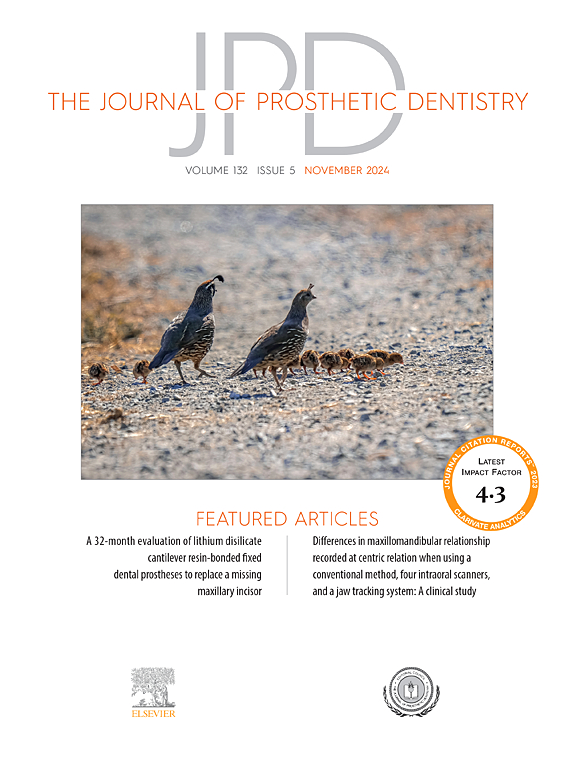Analysis of flexural strength and Weibull modulus of printed and milled zirconia: A systematic review
IF 4.8
2区 医学
Q1 DENTISTRY, ORAL SURGERY & MEDICINE
引用次数: 0
Abstract
Statement of problem
Additive manufacturing (AM) has been used for zirconia dental prostheses, but studies that evaluated mechanical properties in comparison with subtractive manufacturing (SM), such as flexural strength (FS) and Weibull modulus (m), are lacking.
Purpose
The purpose of this systematic review was to evaluate studies comparing the FS and m of zirconia produced by AM and SM.
Material and methods
Searches were conducted in the PubMed, Science Direct, Embase, Web of Science, and Scopus databases, with the keywords zirconium, "zirconium oxide," "3D printing," "additive manufacturing," "additive manufacture," flexural, "flexural strength" from 2019 to 2024, enriched with manual searches.
Results
Few AM technologies are currently available to print dental zirconia, with the most used being stereolithography (SLA), digital light processing (DLP), and lithography-based ceramic manufacturing (LCM) systems. In general, specimens obtained by milling were found to have a higher FS and m than printed specimens.
Conclusions
Printed zirconia has great potential for use in oral rehabilitation because, although its flexural strength and Weibull modulus are lower than those of subtractively manufactured zirconia, they still should provide adequate clinical performance.
印刷氧化锆和研磨氧化锆的抗弯强度和威布尔模量分析:系统综述。
问题说明:增材制造(AM)已用于氧化锆牙科假体,但缺乏与减法制造(SM)比较评估机械性能的研究,如抗弯强度(FS)和威布尔模量(m)。目的:本系统综述的目的是评价比较AM和SM产生的氧化锆的FS和m的研究。材料和方法:在PubMed、Science Direct、Embase、Web of Science和Scopus数据库中进行检索,关键词为锆、氧化锆、3D打印、增材制造、增材制造、弯曲、弯曲强度,检索时间为2019 - 2024年,并进行人工检索。结果:目前很少有AM技术可用于打印牙科氧化锆,最常用的是立体光刻(SLA),数字光处理(DLP)和基于光刻的陶瓷制造(LCM)系统。一般来说,通过铣削获得的样品比印刷样品具有更高的FS和m。结论:虽然印刷氧化锆的抗弯强度和威布尔模量低于减法制备氧化锆,但仍能提供足够的临床性能,在口腔康复中具有很大的应用潜力。
本文章由计算机程序翻译,如有差异,请以英文原文为准。
求助全文
约1分钟内获得全文
求助全文
来源期刊

Journal of Prosthetic Dentistry
医学-牙科与口腔外科
CiteScore
7.00
自引率
13.00%
发文量
599
审稿时长
69 days
期刊介绍:
The Journal of Prosthetic Dentistry is the leading professional journal devoted exclusively to prosthetic and restorative dentistry. The Journal is the official publication for 24 leading U.S. international prosthodontic organizations. The monthly publication features timely, original peer-reviewed articles on the newest techniques, dental materials, and research findings. The Journal serves prosthodontists and dentists in advanced practice, and features color photos that illustrate many step-by-step procedures. The Journal of Prosthetic Dentistry is included in Index Medicus and CINAHL.
 求助内容:
求助内容: 应助结果提醒方式:
应助结果提醒方式:


